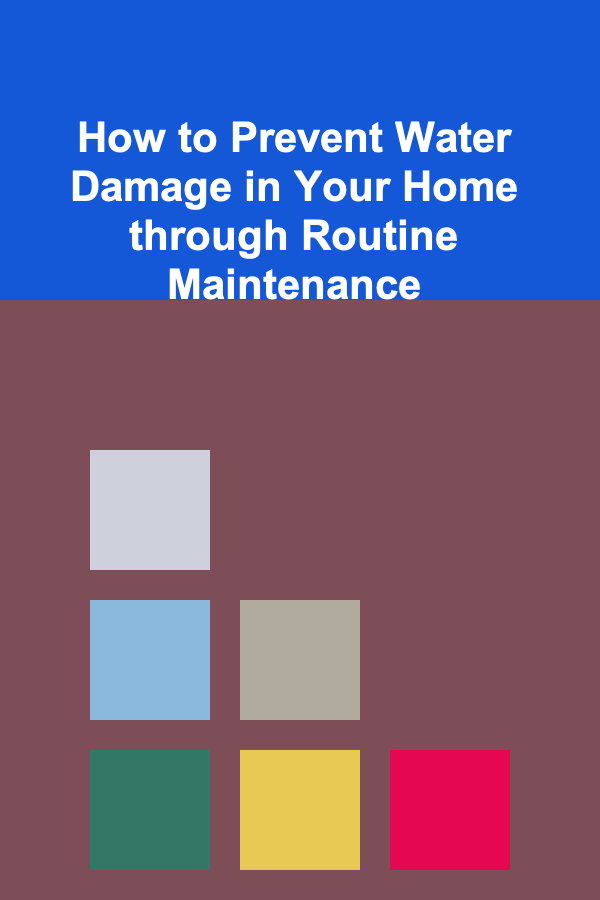
How to Prevent Water Damage in Your Home through Routine Maintenance
ebook include PDF & Audio bundle (Micro Guide)
$12.99$9.99
Limited Time Offer! Order within the next:

Water damage in the home can be a nightmare. It can lead to expensive repairs, mold growth, structural damage, and the loss of valuable belongings. However, water damage doesn't always have to be an inevitable part of homeownership. With routine maintenance and proactive care, you can prevent most instances of water damage and protect your property from unnecessary costs and inconvenience.
In this article, we will explore a detailed guide on how to prevent water damage in your home. We'll go over regular maintenance practices, the importance of understanding common sources of water damage, and how to take preventive measures before issues escalate.
The Importance of Preventative Maintenance
Preventative maintenance is a crucial aspect of homeownership. Regular upkeep can identify potential issues before they worsen. Just as you might maintain your car or health through routine checks, your home's infrastructure requires the same level of attention. Ignoring minor problems such as a small leak or clogged gutter can escalate into major issues over time. By investing in preventative maintenance, you can:
- Reduce repair costs: Catching issues early can often be less expensive than fixing severe damage.
- Increase home value: A well-maintained home retains its value and appeal to prospective buyers.
- Ensure safety: Water damage can sometimes lead to structural issues or mold, which can impact your health and safety.
- Prevent inconvenience: Water damage can disrupt daily living. Preventing it ensures peace of mind.
Common Causes of Water Damage in Homes
Before diving into specific preventive measures, it's important to understand the common causes of water damage. These causes often lead to minor issues that can develop into significant problems if not addressed.
1. Leaky Roofs
Roofs are designed to shield your home from the elements, but over time, shingles can degrade, flashing can wear out, and structural issues may arise. If these issues aren't addressed, water can seep into your home during rainstorms, causing damage to ceilings, walls, and floors.
2. Clogged Gutters and Downspouts
Gutters play a critical role in diverting rainwater away from your home's foundation. If gutters become clogged with leaves, debris, or other obstructions, water can overflow, damaging the roof, walls, and foundation. Furthermore, clogged gutters can also lead to mold growth or pest infestations.
3. Broken Pipes and Plumbing Leaks
Plumbing issues are one of the most common causes of water damage. Leaking or burst pipes can flood a room, soak carpets, ruin flooring, and cause mold and mildew growth. These problems often stem from aging pipes, high water pressure, or freezing temperatures that cause pipes to burst.
4. Faulty Appliances
Certain household appliances such as washing machines, dishwashers, and water heaters rely on a steady supply of water. If any of these appliances malfunction, water can spill into the home. Leaky hoses, blocked drains, or malfunctioning seals can cause water to damage nearby floors, walls, or cabinets.
5. Foundation Cracks and Poor Drainage
Water pooling around your home's foundation can seep through cracks or gaps, leading to water infiltration in your basement or lower levels. Poor drainage systems or an improperly sloped yard can exacerbate this problem by directing rainwater toward the foundation rather than away from it.
6. Humidity and Condensation
Excessive humidity in your home can also be a source of water damage. Condensation can build up on windows, walls, and floors, leading to mold growth or damage to materials. Improperly ventilated areas such as bathrooms and kitchens are particularly prone to this issue.
Routine Maintenance Tasks to Prevent Water Damage
The good news is that most instances of water damage can be prevented with regular checks and proper maintenance. Below is a comprehensive guide to routine maintenance tasks that can safeguard your home from water damage:
1. Regular Roof Inspections
Your roof is the first line of defense against water. It's essential to check your roof regularly for any signs of damage. Here's how you can ensure its longevity:
- Inspect shingles: Look for missing, cracked, or curling shingles. Replace any damaged shingles promptly.
- Check flashing: Flashing around chimneys, vents, and skylights is prone to wear and tear. If it becomes loose or cracked, it can allow water to seep in.
- Clean the roof: Remove any leaves, debris, or moss buildup, which can cause water to accumulate.
- Look for signs of water damage: Inspect your attic or ceiling for signs of leaks or water stains. If you find any, have the roof repaired immediately.
A roof inspection should be done at least twice a year---once in the spring and once in the fall---and after any major storms.
2. Clean and Maintain Gutters and Downspouts
Clogged gutters are one of the leading causes of water damage in homes. To avoid this, make it a habit to clean your gutters regularly. Here's how:
- Clean gutters at least twice a year: In areas with heavy foliage, clean gutters more frequently to prevent clogging.
- Inspect downspouts: Ensure that the downspouts are properly directing water away from the foundation. Water should flow freely through them.
- Check for leaks or sagging gutters: Ensure that gutters are securely fastened and free from holes or cracks.
- Install gutter guards: Gutter guards help reduce the amount of debris that accumulates in gutters, reducing the frequency of cleaning.
3. Inspect Plumbing Systems
Routine plumbing maintenance can help identify potential leaks or weaknesses before they cause damage:
- Check for leaks: Inspect under sinks, around toilets, and around water-using appliances for signs of leaks. Tighten any loose connections.
- Replace old pipes: If you live in an older home, it may be time to replace aging pipes that are prone to leaks. Consider upgrading to more durable materials such as copper or PVC.
- Insulate pipes: During winter, pipes are vulnerable to freezing and bursting. Insulate pipes in unheated areas such as basements, attics, and crawl spaces to prevent this issue.
- Check water pressure: High water pressure can damage pipes and cause leaks. Consider installing a pressure regulator if your water pressure is too high.
4. Monitor Appliances
Appliances such as washing machines, dishwashers, and refrigerators can often be the source of water damage if not maintained properly. Here's what you should do:
- Inspect hoses: Check the hoses of appliances that use water. Look for signs of wear, cracks, or bulges and replace them if necessary. For washing machines, consider using braided steel hoses, which are more durable than rubber.
- Check seals: Examine seals around appliances like dishwashers and refrigerators. If you notice any cracks or damage, replace the seal to prevent leaks.
- Maintain water heaters: Flush your water heater annually to remove sediment buildup, which can cause rust or leaks. Check for leaks around the base of the water heater as well.
5. Ensure Proper Drainage Around the Foundation
Water pooling around your foundation can lead to serious structural damage. To prevent this:
- Grade the landscape: Ensure that the ground around your home slopes away from the foundation. This will direct rainwater away and prevent water from seeping in.
- Install a French drain or sump pump: If your home is prone to flooding or has a high water table, a French drain or sump pump can help divert water away from the foundation.
- Inspect foundation cracks: Regularly check for cracks in the foundation and repair them as soon as possible. Small cracks can expand over time, allowing water to infiltrate the basement.
6. Control Indoor Humidity
Controlling the humidity levels in your home can help prevent moisture-related water damage such as mold growth or condensation:
- Use dehumidifiers: In areas like basements or bathrooms, use dehumidifiers to keep moisture levels in check.
- Ventilate moisture-prone areas: Ensure that bathrooms, kitchens, and laundry rooms are properly ventilated. Install exhaust fans to remove excess moisture from the air.
- Use moisture-absorbing products: Consider using moisture-absorbing products, such as silica gel packets or desiccants, in areas with high humidity.
7. Monitor the Basement and Crawl Spaces
Basements and crawl spaces are particularly vulnerable to water damage. Here's how to protect these areas:
- Inspect for standing water: Regularly check your basement or crawl space for signs of standing water. If you find any, investigate the cause and fix it.
- Install a sump pump: In areas prone to flooding, installing a sump pump can help prevent water from accumulating in the basement.
- Seal cracks: Seal any cracks in the foundation, walls, or floor to prevent water from entering.
8. Regular Mold Inspections
Mold thrives in damp environments and can cause significant damage to both your home and health. To avoid mold growth:
- Inspect for leaks: Regularly check for leaks around windows, doors, plumbing, and appliances.
- Address moisture immediately: If you notice any damp or wet areas, dry them as quickly as possible.
- Use mold-resistant products: Consider using mold-resistant paints or materials in areas prone to moisture, such as bathrooms or basements.
Conclusion
Water damage is one of the most preventable problems a homeowner can face, but it requires diligence and routine maintenance. By staying proactive with regular inspections, repairs, and maintenance, you can protect your home from costly repairs, health hazards, and the frustration of water-related issues. Whether it's cleaning your gutters, checking for leaks, or monitoring indoor humidity levels, a little effort can go a long way in preserving your home and ensuring its safety for years to come.
Reading More From Our Other Websites
- [Home Lighting 101] How to Achieve the Perfect Cozy Ambiance: Living Room Lighting Ideas & Techniques
- [Personal Investment 101] How to Use Fundamental Analysis for Smarter Investment Decisions
- [Sewing Tip 101] Elegant Upholstery Makeovers: Reupholster Chairs and Ottomans on a Budget
- [Home Holiday Decoration 101] How to Create a Holiday Decor Theme Around Your Favorite Tradition
- [Home Storage Solution 101] How to Organize Your Home Office for Peak Productivity
- [Home Security 101] How to Improve Home Security Without Overhauling Your Current System
- [Organization Tip 101] How to Prepare for Inclement Weather on Yard Sale Day
- [Personal Financial Planning 101] How to Start Investing for Retirement with Just $100 a Month: A Beginner's Guide Using Online Brokers
- [Toy Making Tip 101] Plan < Build < Play: A Guide to Thoughtful Toy Creation
- [Beachcombing Tip 101] From Driftwood to Sea Glass: Crafting Souvenirs on a Beachcombing Expedition

How to Create a Sustainable Decluttering Plan
Read More
How to Create a Vision Board to Stay Inspired
Read More
How to Create an Inspiring Camp Culture Through Organization
Read More
How to Organize Your Jewelry Collection Effectively
Read More
The Chief Operating Officer's Playbook: Navigating Complex Operations with Efficiency
Read MoreHow to Choose the Best Savings Account Tracker for Your Financial Goals
Read MoreOther Products

How to Create a Sustainable Decluttering Plan
Read More
How to Create a Vision Board to Stay Inspired
Read More
How to Create an Inspiring Camp Culture Through Organization
Read More
How to Organize Your Jewelry Collection Effectively
Read More